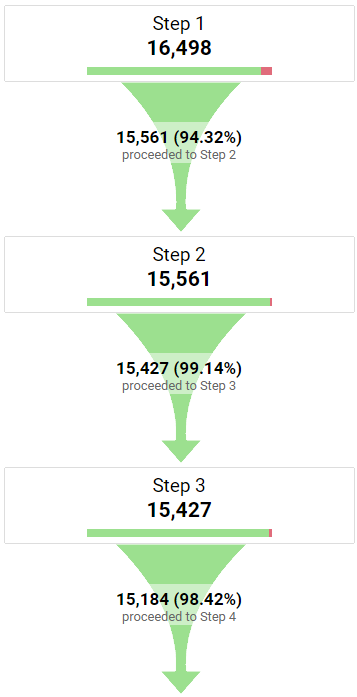Comprehensive Checklist of What Data Is Google Analytics Goals Unable to Track
Comprehensive Checklist of What Data Is Google Analytics Goals Unable to Track
Blog Article
Unveiling the Blind Destinations: Recognizing What Google Analytics Goals Can not Measure
In the world of digital analytics, Google Analytics stands as a powerful tool for tracking and assessing on the internet individual interactions. However, in the middle of its durable capabilities, there exist blind places that usually escape dimension. Comprehending what Google Analytics goals can not determine is critical for getting a thorough sight of individual actions and involvement. As we explore the details of these blind places, we uncover a complicated web of undiscovered territories that hold beneficial understandings into customer activities and inspirations, tough conventional knowledge and dropping light on the limitations of our data-driven understanding.
Individual Behavior on External Platforms
Comprehending exactly how users connect on outside systems is vital for optimizing online strategies. External platforms, such as social media networks, reference sites, and online forums, play a substantial role in driving traffic to a firm's site. By analyzing individual habits on these systems, companies can gain useful insights right into the efficiency of their marketing efforts and the preferences of their target audience.
One key aspect of individual actions on external systems is the referral resource. By tracking where the individuals are coming from, services can determine which platforms are driving the most traffic to their website. This details can assist companies allot their resources more properly, concentrating on the platforms that produce the most effective results.

Offline Conversions and Interactions
Evaluating individual actions on external platforms gives valuable insights into on-line techniques; nonetheless, considering offline conversions and communications is just as essential for an extensive understanding of a company's overall performance. Offline conversions, such as in-store purchases or phone queries, play a considerable duty in many businesses' success.

Acknowledgment Beyond Last Click
When diving right into the world of electronic advertising and marketing analytics, it comes to be necessary to look past the solitary touchpoint of the last click for a more detailed understanding of attribution. While Google Analytics offers useful insights right into customer actions, relying solely on last-click acknowledgment can be restricting - what data is google analytics goals unable to track. Attribution versions that exceed the last click offer an extra nuanced sight of the consumer journey, thinking about all the touchpoints that bring about a conversion
Acknowledgment past the last click allows marketers to designate debt to various communications along the conversion path, providing a clearer photo of the effectiveness of various marketing networks. By discovering multi-touch get more attribution models such as linear, time decay, or position-based acknowledgment, organizations can much better allot their advertising spending plans and optimize their approaches for maximum influence.
Recognizing the impact of each touchpoint in the conversion process is important for making informed decisions and maximizing ROI. By accepting attribution beyond the last click, organizations can get deeper insights right into client behavior and customize their marketing efforts better.
Cross-Device and Cross-Browser Tracking

Likewise, cross-browser monitoring enhances cross-device tracking by recording user behavior as they switch over in between various internet browsers. Comprehending exactly how users communicate with web sites on numerous browsers can assist marketing professionals maximize their online experiences to guarantee uniformity and performance across different systems.
Qualitative Information and User Intent
Recognizing customer intent via qualitative information evaluation is important for creating targeted electronic advertising and marketing methods that resonate with the requirements and preferences of the target audience. Qualitative information gives understandings into the 'why' behind customer activities, clarifying motivations, emotions, and preferences that measurable data alone can not capture. By evaluating user feedback, remarks, and communications, marketers can reveal beneficial info about customer intent, allowing them to customize their messaging, material, and offerings to much better line up with what their target market is looking for.
Qualitative information likewise assists in recognizing the context Full Article in which users engage with a web site or app. This contextual understanding enables marketing professionals to create even more tailored and appropriate experiences, eventually driving higher engagement and conversion rates. By diving into customer intent with qualitative information analysis, organizations can obtain a much deeper understanding of their target market, resulting in a lot more efficient advertising techniques that meet individuals' assumptions and requirements.
Verdict
In conclusion, Google Analytics objectives next page have constraints in measuring user habits on exterior systems, offline conversions, attribution past last click, cross-browser and cross-device monitoring, and qualitative data associated with user intent. what data is google analytics goals unable to track. It is necessary for organizations to be mindful of these unseen areas in order to supplement their information evaluation with other devices and approaches to acquire a much more detailed understanding of their audience and boost their general digital marketing strategies
By examining customer actions on these systems, businesses can acquire beneficial understandings into the efficiency of their advertising and marketing efforts and the preferences of their target audience.
Analyzing individual behavior on external systems gives valuable understandings right into online techniques; however, taking into consideration offline conversions and interactions is equally important for a detailed understanding of a company's overall efficiency.In digital marketing analytics, moving beyond last-click attribution to discover cross-device and cross-browser monitoring is essential for obtaining an all natural understanding of customer interactions throughout different systems and gadgets. By examining customer comments, comments, and interactions, online marketers can reveal important details about individual intent, permitting them to customize their messaging, web content, and offerings to much better line up with what their target market is seeking.
By diving into user intent with qualitative data evaluation, businesses can obtain a deeper understanding of their target audience, leading to much more effective advertising and marketing approaches that meet users' demands and expectations.
Report this page